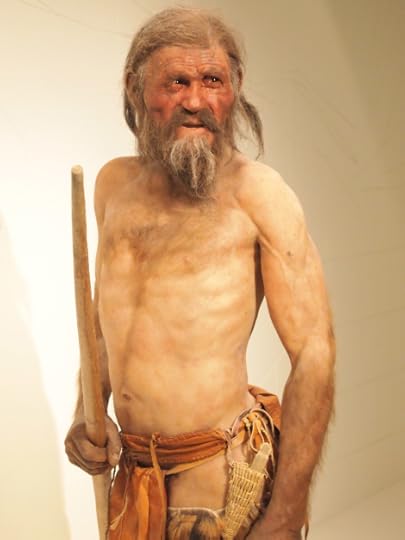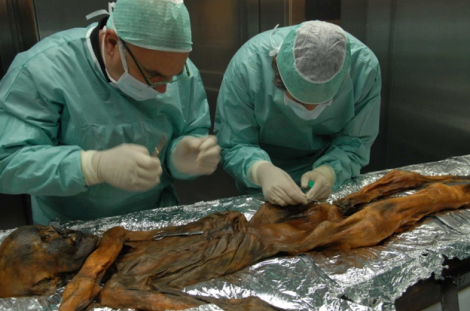Otzi the Iceman
Otzi the Sudtirol Iceman
A startling discover
In September, 1991, a German couple from Nuremberg were hiking across the Otzal alps on the border between Austria and Italy. Hiking at 3200 meters, they found a strange object partially exposed in glacial ice.
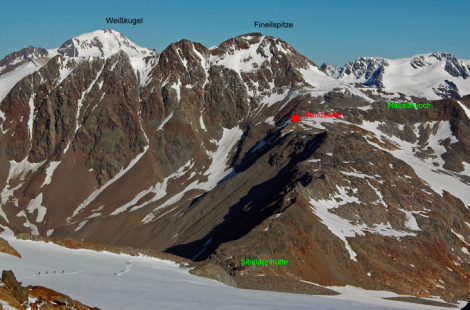
Otzal alps
They suspected it was the body of a mountaineer and trekked to a national park office to notify a ranger. They returned to the site the next day with the ranger who suspected it might be a missing mountaineer from long ago. The ranger notified the Austrian police who arrived later that day in a helicopter.
When the police studied the remains, they originally suspected a possible murder and that the victim had been stripped to prevent identification. Another theory was that the remains were those of an Italian soldier missing since the Great War. Word spread quickly in alpine communities and experienced hikers began arriving at the site.
Recovering the remains
A three-day excavation began, but bad weather, hard ice, and difficult terrain made it difficult to remove the body from the ice. Drills and axes were used and the remains were whisked off to the University of Innsbruck since it was thought that the site was in Austria. Police and hikers began recovering objects around the body which appeared to be remnants of clothing, tools, and primitive weapons.
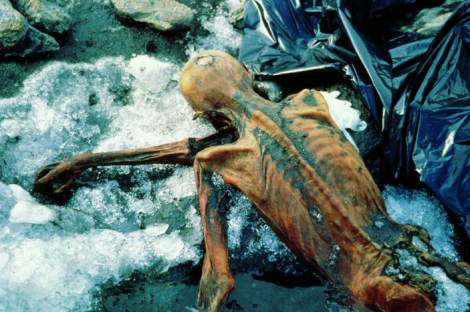
Otzi’s remains frozen in glacial ice
The first examinations were conducted at the University of Innsbruck. A survey of the site determined that the remains were less than 100 meters inside the Italian border. Italian authorities gave the Austrian authorities permission to continue research rather than risk moving the remains and possibly damaging scientific evidence.
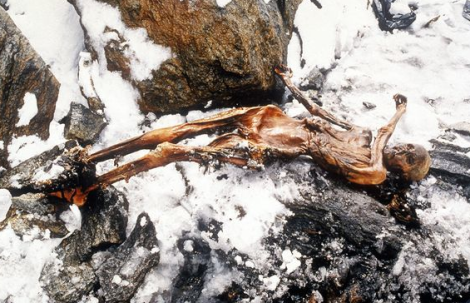
Otzi’s remains recovered from ice
A peak into Neolithic times
Scientists from around the world began a comprehensive investigation into the remains as well as artifacts recovered from the site with advanced scientific instruments including X-rays, CAT scans, MRI, and powerful microscopes. Because the remains were discovered in the Otzal alps, he was named Otzi.
What scientists discovered was a treasure of artifacts that allowed them to better understand daily life during the Neolithic era. Otzi’s body is the oldest mummy preserved from European history.
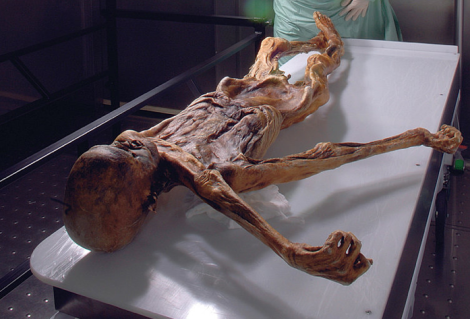
Otzi in laboratory
Research determined that Otzi was about 45 years old when he died around 3500 BC.
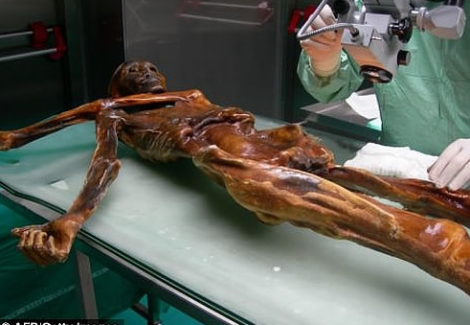
Naturally preserved Otzi
One puzzling feature of Otzi’s body were some fifty tattoos on his legs and feet. Forensic pathologists believed they were evidence of primitive medical treatment similar to acupuncture. Crude incisions were made in his skin near joints and then smeared in charcoal.
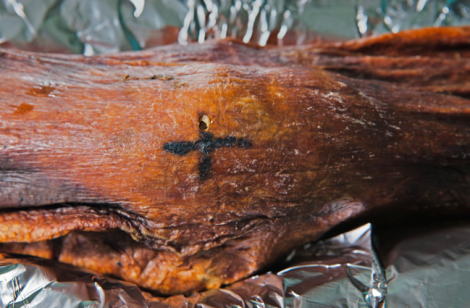
Tatto on Otzi’s leg
A sick old man
Decades of research allowed scientists to determine the state of Otzi’s health, his illnesses, and possible involvement in forging copper. The state of Otzi’s health was not good; he had parasitic worms in his gut, heart disease, diseased joints, and high level of arsenic possibly linked to his work forging copper to make weapons and tools.
PBS presented a documentary about the forensic science that examined minute bits in Otzi’s transverse colon which turned out to be parasitic worms as well as fragments of his last meal. Otzi had eaten about eight hours before he died. His last meal included ibex meat, a bread made from einkorn, barley seeds and berries from native trees.
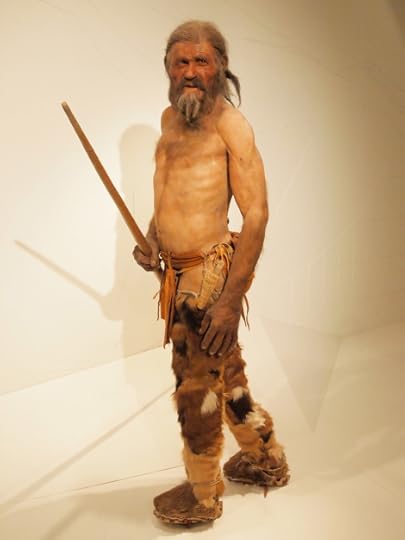
Otzi, rugged and lean, but hard muscled from lifetime of hiking in the alps
Things Otzi carried with him
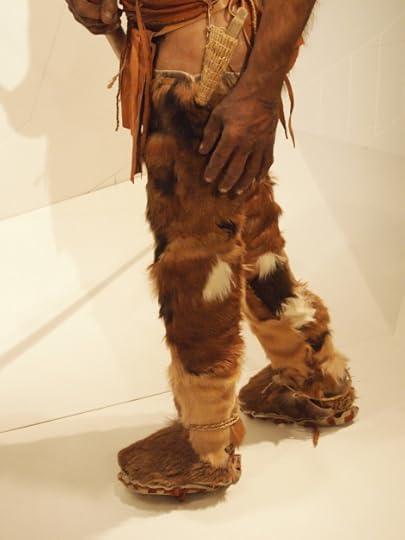
Otzi’s leggings, shoes, and sheathed flint knife
On Otzi last hike across the alps, he wore leggings sewn from goat leather of two colors; shoes made from bear fur, a fur cap, a blouse made from goat leather, and a twine belt.
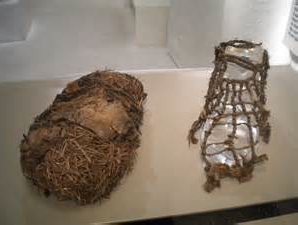
Otzi’s bear fur shoes bound in twine
Otzi was carrying tools and weapons on his last hike; a forged copper axe, a long wooden shaft that was probably being made into a bow, and twelve arrow shafts in a goat leather quiver. Two arrows had flint arrowheads, the others were shafts that had not been finished making into arrows. Otzi was carrying flint and material in his quiver to finish more arrows.
Otzi also carried a flint knife with a yew handle kept in a sheath made from grass.

Otzi’s goat skin quiver and arrow shafts
Centuries old Unsolved murder
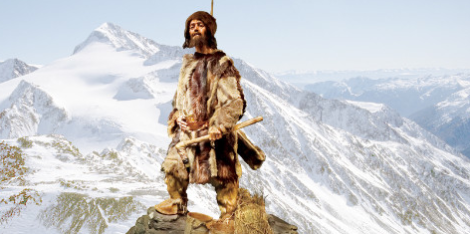
How Otzi might have appeared on his last hike across the alps 5500 years ago
Recent forensic evidence convinced scientists that Otzi met a grizzly ending on his last journey. He was attacked on an alpine path about two hours after his last meal of ibex, roots, and grain. One or more of his attackers shot him in the back with an arrow, clubbed the back of his head, and stabbed him in the chest. He died from the blow to his head.
Otzi’s body was frozen within hours, possibly by heavy snowfall which turned to glacial ice and preserved his body for more than fifty centuries.
Preserving Otzi for the world
Otzi’s final resting place is at the Sudtirol Archeological Museum in Bolzano. The discovery of Otzi was so significant, the Sudtirol government built the museum just for him.
And a fascinating museum it is with photos and videos of the excavation, exhibits on scientific research from Otzi’s tools, weapons, and clothing.
Two exhibits in the museum are stunning; shortly after entering the museum, viewers can step onto a platform in a darkened room and look through glass at Otzi’s body preserved in an ice box, lying on a gurney, under bright lights, naked for the world to see. Otzi’s muscles have atrophied, but he looks like he’s asleep, one arm stretched across his chin like he had fallen onto rocks after being struck on the back of his head.
At the end of the exhibition artists have made a life-sized model of Otzi, bare-chested and alert, as he might have appeared in his last years.

Model of Otzi the Sudtirol Iceman
Photos from Sudtirol Archeological Museum
* * * * *
Next: Leipzig and Johann Sebastian Bac



